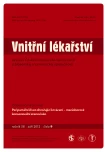Morbus Weil – a case study and principles
Authors:
P. Majdák 1; I. Drexlerová 1; M. Staňáková 1; P. Malinjak 2; J. Melicherík 3
Authors‘ workplace:
Geriatrické oddelenie NsP Bojnice, Slovenská republika, prednosta prim. MUDr. Pavol Majdák
1; Infektologická ambulancia NsP Bojnice, Slovenská republika, vedúci lekár MUDr. Peter Malinjak
2; Neurologické oddelenie NsP Bojnice, Slovenská republika, prednosta prim. MUDr. Andrej Mihál
3
Published in:
Vnitř Lék 2012; 58(9): 668-673
Category:
Case Reports
Overview
We present a case of a 66 years old man without significant medical history who was admitted to a geriatric department of a local hospital for a critical clinical state with severe icterus (billirubin 368 µmol/l), acute renal failure (urea 48 mmol/l, creatinine 714 µmol/l) and severe thrombocytopaenia. When the patient’s son completed his personal history on the 4th day of hospitalization reporting that the patient had worked in a pub flooded during local floods, we also considered leptospirosis as a potential cause of his current state. Parenteral penicillin antibiotics (amoxicillin + clavulanate) were prescribed and comprehensive infusion rehydration, corrective and haemostyptic treatments were continued. Despite transient worsening of thrombocytopaenia to 8 × 103/µl, we did not observe any severe bleeding, thrombocytopaenia gradually improved and thrombocyte levels were in the reference range from the 7th day of hospitalization. Acute renal failure (ARF) did not involve oliguria and an intensive conservative treatment provided gradual improvement of the clinical status as well as laboratory parameters with creatinine levels at discharge of 121.3 µmol/l. Heamodialysis was not used. Billirubin levels also gradually declined to 25 µmol/l at discharge. Leptospiral antibodies in the urine and serum were suggestive of leptospirosis. The diagnosis was confirmed with follow up investigations 13 days after discharge. The condition was caused by Leptospira icterohaemorrhagiae. The patient’s condition was complicated with deterioration of pre-existing hearing impairment. We also expect a contribution of leptospirosis to its anamnesis. Antibiotic treatment continued for 16 day, 7 of which with parenteral administration. Haemodynamically stable, normotensive, afebrile, self-sufficient patient was discharged on 37th day of hospitalization to primary care.
Key words:
leptospirosis – Weil’s disease – renal failure – icterus – thrombocytopaenia
Sources
1. Štefanovič J. Lexikón lekárskej bakteriológie. Bratislava: SLK 2008: 42–43.
2. Lewet PN, Edwards CN. Leptospirosis. In: Brachman PS, Abrutyn E (eds). Bacterial Infections of Humans. 4th ed. New York: Springier Science + Business Media LLC 2009: 439–460.
3. Zitek K, Beneš Č. Dlhouhodobá epidemiologie a diagnostika leptospirózy (1963–2003) v České republice. Praha: Národní referenční laboratoř pro leptospiry: SZÚ Praha 2003.
4. Guron G, Holmdahl J, Dotevall L. Acute renal failure after a holiday in the tropics. Clin Nephrol 2006; 66: 468–471.
5. Souček M, Charvát J, Večeř J et al. Infekční onemocnění zpúsobené leptospirou s následným akutním selháním ledvin. Klin Mikrobiol 2000; 4: 128–129.
6. Erdinc FS, Koruk ST, Hatipoglu CA. Three cases of anicteric leptospirosis from Turkey: Mild to severe complications. J Infect 2006; 52: e45–e48.
7. Coursin DB, Updike SG, Mai DG. Massive rhabdomyolysis and multiple organ dysfunction syndrome caused by leptospirosis. Intensive Care Med 2000; 26: 808–812.
8. Frančíková K, Hamplová V, Petrú K et al. Akutní selhání ledvin při leptospiróze. Postgrad Med 2007; 9: 395–396.
9. Čermáková Z, Plíšková L, Ryšková O. Laboratory Diagnosis of Leptospirosis. Folia Microbiol 2005; 50: 345–347.
10. Gompf SG, Velez APV. Leptospirosis. MedScape.com. Emedicine.medscape.com/article/220563-overview. Updated: Aug 11, 2008.
11. Da Silva PS, Lipinski RW, Magalhães RP et al. Severe acute renal failure in a child: a rare complication of anicteric leptospirosis. Pediatr Nephrol 2007; 22: 1971–1974.
12. Araujo ER, Seguro AC, Spichler A et al. Acute kidney injury in human leptospirosis: an immunohistochemical study with pathophysiological correlation. Virchows Archiv 2010; 456: 367–375.
13. Nakou N, Liamis G, Elisaf MS et al. Low Normal Potassium Levels in Acute Renal Failure: Evidence of Leptospirosis. Infection 2000; 28: 196.
14. Daher EF, Silva GB Jr, Karbage NN et al. Predictors of oliguric acute kidney injury in leptospirosis. A retrospective study on 196 consecutive patients. Nephron Clin Pract 2009; 112: c25–c30.
15. Covic A, Goldsmith DJ, Gusbeth-Tatamir P et al. A retrospective 5-year study in Moldova of acute renal failure due to leptospirosis: 58 cases and a review of the literature. Nephrol Dial Transplant 2003; 18: 1128–1134.
16. De Souza AL, Sztajnbok J, Marques SR et al. Leptospirosis-induced meningitis and acute renal failure in a 19-month-old male child. J Med Microbiol 2006; 55: 795–797.
17. Andrade L, Cleto S, Seguro AC. Door-to-dialysis time and daily hemodialysis in patients with leptospirosis: impact on mortality. Clin J Am Soc Nephrol 2007; 2: 739–744.
18. Niwattayakul K, Sitprija V. Leptospiral Acute Renal Failure: Effects of Dopamine and Furosemide. Ren Fail 2007; 29: 159–162.
Labels
Diabetology Endocrinology Internal medicineArticle was published in
Internal Medicine

2012 Issue 9
Most read in this issue
- Superficial thrombophlebitis, unjustly underestimated disease – has the time come to change our view?
- Warning about risk of invasive infections in splenectomized patients. Experiences from University Hospital Brno, Czech Republic, in 2011
- Morbus Weil – a case study and principles
- Hyperventilation echocardiography in spastic angina pectoris diagnosing
